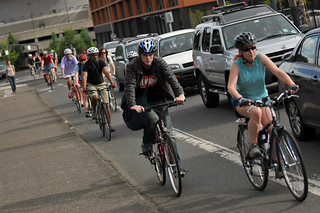
shows huge spikes in bike traffic.
(Photo © J. Maus/BikePortland)
Almost every transportation statistic you see has to do with one kind of trip: commuting to work. That’s the only one the Census Bureau asks people about.
But once in a while, someone outside the Census Bureau does research into the 85 percent of trips that don’t involve going between home and work: the coffee shop, the dinner party, the soccer field. And a new survey released by Metro Tuesday morning has some surprising insights about how Portland’s transportation transformation since 1994 has affected our non-working lives – especially the ways biking has competed with and complemented other forms of low-car travel.
All of these numbers are demographically weighted estimates based on a 2011 survey of 6,450 households in the Portland metro area, including Clark County on the Washington side of the Columbia River.
The key to low-car life: dense neighborhoods. Across the region, the number of people living low-car lives doesn’t look too impressive. Use of bikes rose from 1 percent of all trips in 1994 to 3 percent in 2011; use of transit rose from 3 percent to 4 percent of trips. But break that down by geography, and the story changes fast.
For residents of the “Central City” immediately surrounding downtown on both sides of the river – neighborhoods like Goose Hollow, the Pearl District, South Waterfront and east side as far as 12th Avenue – biking leaped from 3 percent to 13 percent. Transit use in that area jumped from 10 percent to 22 percent.
Public transportation doesn’t seem to be driving low-car life on the middle east side and North Portland – bikes are. Transit use is up across the region. But north of the Fremont Bridge, and between 12th Avenue and I-205, it’s been stalled at 6 percent for 17 years. Since TriMet has spent several hundred million dollars to build the Yellow, Red and Green MAX lines and a network of frequent service bus lines, this is pretty surprising.
And guess what? Bike trips in this area quadrupled, from 2 percent to 8 percent.
All transit growth in Portland since 1994 seems to have come from people who own cars. Transit trips by zero-car households dropped from 35 percent of trips to 31 percent of trips.
It may seem as if no-car households don’t have many other options. But look at those numbers again: even in 1994, car-free families had lots of options. Sixty-five percent of their trips weren’t happening by transit – they were happening on foot, by carpool or by bike.
If all the transit improvements since 1994 were substantially improving the lives of car-free households, you’d expect transit use to increase. It hasn’t. (Unfortunately, the survey didn’t report on bike use among car-free households, but in an asterisk, Metro staff noted that they suspect more zero-car households are turning to bikes.)
Who loves public transit? Young people. In every age group under 45, transit use nearly doubled. The fastest growth: 35-to-44-year-olds. Their transit use jumped from 2 percent to 5 percent. The most popular ages for transit ridership? High school and young adulthood. Transit ridership for people age 15 to 24 is up from 5 percent to 10 percent.
The only age group that now uses public transit less: people between ages 55 and 64.
This is another question Metro didn’t measure among bicyclists, probably because the sample size was too small to be reliable. But to me, it suggests two possibilities: that Gen Xers and millennials are embracing low-car life far more than their parents did, and that the faster growth of transit use among the middle-aged suggests an even faster growth of bicycling among young adults.
There are plenty of other stories to be told with this fascinating data – I’m especially interested in the ways walking has changed – but have a look at the numbers for yourself; and add your own thoughts in the comments. And while you’re doing it, ask yourself which of the Portland area’s transportation investments seem to be paying off the most.
Update:
In a follow-up interview, Metro Councilor Rex Burkholder said these initial figures support his conviction that “we should be spending more” on bike and pedestrian infrastructure.
“If we get a 5 percent drop on a freeway for a major expansion, that’s considered a victory; here we’ve got 13 percent of people in the central city getting around on bikes,” Burkholder said. “That’s huge.”
The shift was also, Burkholder said, cheap.
“Getting bike lanes on the road was a policy decision that cost almost nothing,” said Burkholder, who co-founded the Bicycle Transportation Alliance in the early 1990s.
Burkholder also said it makes sense that public transit has grown faster among work trips than overall trips. “Transit still is growing mostly for that work commute,” he noted. “It tends to be people’s longest trip. … That’s why light rail is good.”

